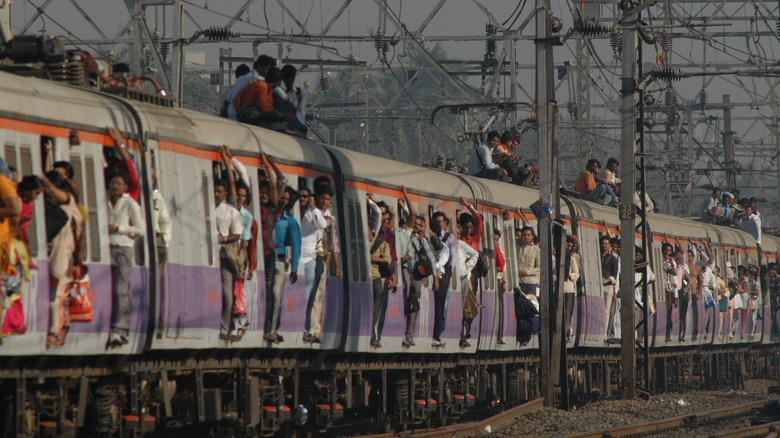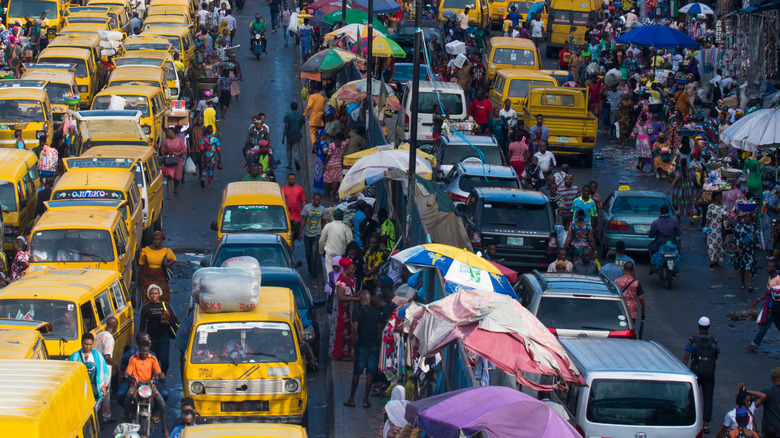Despite Low Birth Rates, Global Population Hits An All-Time High
A declining population can create some serious social problems, and according to NPR, birth rates are slowing down across the globe. A recent United Nations report has confirmed that population growth is at the slowest it has been since 1950. Yet despite all this, the world's population is at an all-time high — and the eighth-billionth person was born on November 15, 2022.
There are roughly 1 billion extra people on Earth since 2011, but they haven't necessarily been born where we need them the most. Caught in a frustrating no-win demographic scenario, the Earth has both too many and too few people at the same time. Although global birth rates are projected to keep falling, the world's population is expected to increase to 10.4 billion by 2080 (via CNN). To put that in perspective, there were fewer than 2 billion people in 1900 (via PRB).
Dangerous population pressure not only damages the environment, but it also increases the likelihood of disease and creates resource scarcity (via the University of California, Berkeley). The looming problems created by runaway climate change are likely to make the lack of clean water a particularly fraught issue over the next century (via the United Nations).
Live long and prosper
Why is the population climbing so fast even as birth rates continue to fall? One major reason outlined in the United Nations report is life expectancy — people are simply not dying young enough or fast enough thanks to better medical care. There are now more old people than ever before, and they are getting older; it has been projected that 16% of the world's population will be over 65 by 2050. A greying population comes with a lot of social problems, as there are fewer young people to care for those at retirement age, many of whom potentially have long-term medical issues in their winter years (via the World Health Organization).
Japan, for example, already has a disproportionate number of elderly people (around 15% of Japanese people are over 75), a situation that has put major pressure on Japanese health services and society at large (via The Japan Times). Many wealthy countries are already taking steps to encourage childbirth. In Italy, for example, families are paid to have kids, while in Scandanavia, generous benefits and maternity leave are available for expectant mothers (via the BBC).
On the plus side, you, too, are one of the beneficiaries of this boom in longevity. On average, most people around the world can now expect to live to the ripe old age of 72.8 — a number that is projected to keep rising (per the United Nations).
China's big shrink
In addition to rising life expectancy, some places around the globe are still growing relatively fast. Africa and Asia in particular have produced the top eight projected population growers — countries that will contribute more than half of the increase in global population leading up to the year 2050 (via the United Nations). Among them, India will be the most populous country on Earth in 2023 (via CNN).
On the other hand, the previous front-runner, China, is expected to see its population shrink from the 1.4 billion mark (via The Guardian). Fears that China, too, could wind up with an upside-down population pyramid have created a dramatic shift in social policy in recent years. The controversial one-child policy, a short-sighted attempt to slow population growth, was brought to an end in 2016 amid fears that the resulting drop in population could damage the economy (via the BBC).
Once favored by companies as an endless source of cheap labor, China's population shrink is predicted to drive up labor costs in the years to come. As of 2021, a solution in the form of the "three-child policy" was introduced — but thus far, women in China remain reluctant to have more children.
India takes the crown
Although India's birth rate is also slowing quite dramatically and has finally hit replacement level (2.1 births per woman), India is still set to hit 1.7 billion people by 2048 (via the Indian Express). The state of Uttar Pradesh alone is home to more than 200 million people, as many as Brazil and Nigeria (via Standford University). Although India's enormous population has been a boon to its economy in some ways, anybody who has tried to catch a busy train in India will know that the crush created by such a large population causes a lot of abject misery. Just this year, a bridge collapsed in the state of Gujarat state due to overcrowding (via The Wall Street Journal).
Population pressures are a particularly big problem in poorer parts of India, where agricultural production cannot meet demand. In 2015, over half the population of India was living below the poverty line (via World Bank). Persistent drought caused by climate change has also exacerbated the problem, creating widespread food scarcity across the subcontinent.
Population spikes in Sub-Saharan Africa
Many of the fastest-growing nations today are in Subsaharan Africa, with Nigeria, Tanzania, and Ethiopia among those leading the way (via the United Nations). Africa on the whole has benefited from enormous improvements in healthcare during the last 50 years. According to the World Bank, child mortality more than halved between the 1950s and 2015, and life expectancy increased by 20 years over the same period. Although concerns over limited resources and heavy urbanization are likely to grow, there are many positives to be found in the demographic data.
If predictions hold true, Subsaharan Africa will inevitably become home to the world's largest mega-cities by the year 2100 (via Business Insider Africa). Lagos in Nigeria — already bursting with 20 million people — could contain as many as 80 million people by the end of the century, making it the world's biggest city. Although birthrates across Subsaharan Africa have also been falling, they remain at a relatively high 4.6 births as of 2020 (via the World Bank). According to The Guardian, one-quarter of the world's population will be African by 2050, and a staggering 50% of the world's 20 largest cities will one day be in Africa.
Are there too many or too few people?
Does the data spell disaster, or is it all just doom-mongering? And are there too many or too few people? Some scientists are sure that the Earth has a maximum carrying capacity, after which it cannot support any more human beings (via NBC News). Recent estimates put this at around 9-10 billion people — exactly the figure we're heading for by 2100. Whether this really means we are destined for disaster is impossible to say, and it depends to a large degree on how we continue to consume our resources. If, for example, most Americans switched to a vegetarian diet, there would be far less pressure on available land. Whether this is likely or realistic is another matter.
If you're Elon Musk or you live in shrinking Japan, on the other hand, you might be more concerned that some countries are losing vital workers. Some may object that this argument puts economic concerns over environmental ones. In any case, many demographers believe that declining populations will eventually stabilize (via Wired). In the long run, a less overcrowded Earth should prove to be a good thing.





